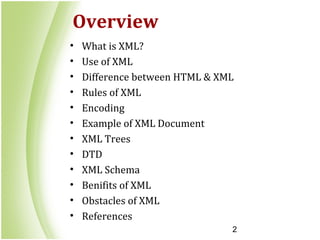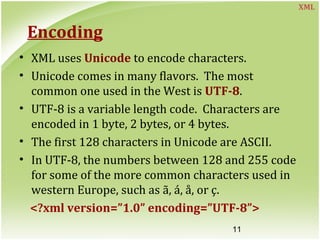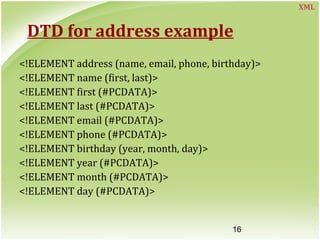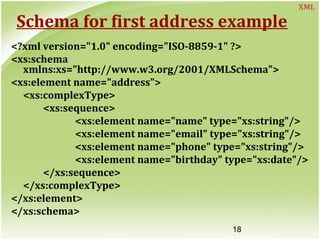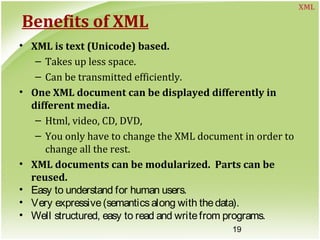XML
- 1. 1
- 2. 2 Overview • What is XML? • Use of XML • Difference between HTML & XML • Rules of XML • Encoding • Example of XML Document • XML Trees • DTD • XML Schema • Benifits of XML • Obstacles of XML • References
- 3. 3 What is XML?? • a family of technologies: - XML 1.0 - Xlink - Xpointer & Xfragments - CSS, XSL, XSLT - DOM - XML Namespaces - XML Schemas XML
- 4. 4 XML Introduction • XML stands for EXtensible Markup Language. • XML is designed to transport and store data. • XML is important to know, and very easy to learn. • XML is a markup language much like HTML. • XML was designed to carry data, not to display data. • Tags are added to the document to provide the extra information. XML
- 5. 5 XML Introduction (cont....) • XML and HTML have a similar syntax … both derived from SGML. • An XML document resides in its own file with an ‘.xml’ extension • officially recommended by W3C since 1998. • primarily created by Jon Bosak of Sun Microsystems. XML
- 6. 6 Why XML is used? • XML documents are used to transfer data from one place to another often over the Internet. • XML subsets are designed for particular applications. • One is RSS (Rich Site Summary or Really Simple Syndication ). It is used to send breaking news bulletins from one web site to another. XML
- 7. 7 Why XML is used? (cont…) • A number of fields have their own subsets. These include chemistry, mathematics, and books publishing. • Most of these subsets are registered with the W3Consortium and are available for anyone’s use. XML
- 8. 8 Quick Comparison HTML • uses tags and attributes. • content and formatting can be placed together <p><font=”Arial”>text </font></p> • tags and attributes are pre-determined and rigid. XML • uses tags and attributes. • content and format are separate, formatting is contained in a stylesheet. • allows user to specify what each tag and attribute means. XML
- 9. 9 The Basic Rules • Tags are enclosed in angle brackets. • Tags come in pairs with start-tags and end-tags. • Tags must be properly nested. – <name><email>…</name></email> is not allowed. – <name><email>…</email><name> is allowed. • Tags that do not have end-tags must be terminated by a ‘/’. – <br /> is an html example. XML
- 10. 10 The Basic Rules(Cont…) • Tags are case sensitive. – <address> is not the same as <Address> • XML in any combination of cases is not allowed as part of a tag. • Tags may not contain ‘<‘ or ‘&’. • Tags follow Java naming conventions, except that a single colon and other characters are allowed. They must begin with a letter and may not contain white space. • Documents must have a single root tag that begins the document. XML
- 11. 11 Encoding • XML uses Unicode to encode characters. • Unicode comes in many flavors. The most common one used in the West is UTF-8. • UTF-8 is a variable length code. Characters are encoded in 1 byte, 2 bytes, or 4 bytes. • The first 128 characters in Unicode are ASCII. • In UTF-8, the numbers between 128 and 255 code for some of the more common characters used in western Europe, such as ã, á, å, or ç. <?xml version=”1.0” encoding=”UTF-8”> XML
- 12. 12 Walking through an Example <?xml version = “1.0” ?> <address> <name> <first>Alena</first> <last>Lee</last> </name> <email>alena@aaol.com</email> <phone>123-45-6789</phone> <birthday> <year>1978</year> <month>09</month> <day>17</day> </birthday> </address> Root Element Parent node of first element Child node of name element Siblings XML
- 13. 13 XML Files are trees address name email phone birthday first last year month day XML
- 14. 14 XML Trees • An XML document has a single root node. • The tree is a general ordered tree. – A parent node may have any number of children. – Child nodes are ordered, and may have siblings. • Pre-order traversals are usually used for getting information out of the tree. XML
- 15. 15 DTD (Document Type Definition) • A DTD describes the tree structure of a document and something about its data. • There are two data types: 1. PCDATA. PCDATA is parsed character data. 2. CDATA CDATA is character data, not usually parsed. • A DTD determines how many times a node may appear, and how child nodes are ordered. XML
- 16. 16 DTD for address example <!ELEMENT address (name, email, phone, birthday)> <!ELEMENT name (first, last)> <!ELEMENT first (#PCDATA)> <!ELEMENT last (#PCDATA)> <!ELEMENT email (#PCDATA)> <!ELEMENT phone (#PCDATA)> <!ELEMENT birthday (year, month, day)> <!ELEMENT year (#PCDATA)> <!ELEMENT month (#PCDATA)> <!ELEMENT day (#PCDATA)> XML
- 17. 17 XML Schema • Schemas are themselves XML documents. • They were standardized after DTDs and provide more information about the document. • They have a number of data types including string, decimal, integer, boolean, date, and time. • They divide elements into simple and complex types. • They also determine the tree structure and how many children a node may have. XML
- 18. 18 Schema for first address example <?xml version="1.0" encoding="ISO-8859-1" ?> <xs:schema xmlns:xs="http://www.w3.org/2001/XMLSchema"> <xs:element name="address"> <xs:complexType> <xs:sequence> <xs:element name="name" type="xs:string"/> <xs:element name="email" type="xs:string"/> <xs:element name="phone" type="xs:string"/> <xs:element name="birthday" type="xs:date"/> </xs:sequence> </xs:complexType> </xs:element> </xs:schema> XML
- 19. 19 Benefits of XML • XML is text (Unicode) based. – Takes up less space. – Can be transmitted efficiently. • One XML document can be displayed differently in different media. – Html, video, CD, DVD, – You only have to change the XML document in order to change all the rest. • XML documents can be modularized. Parts can be reused. • Easy to understand for human users. • Very expressive(semanticsalong with thedata). • Well structured, easy to read and writefrom programs. XML
- 20. 20 Obstacles of XML • XML syntax is too verbose relative to other alternative ‘text-based’ data transmission formats. • No intrinsic data type support. • XML syntax is redundant. XML
- 21. 21 References • W3Schools Online Web Tutorials, http://www.w3schools.com. • www.tutorialpoint.com • www.basicxml.com • www.slideshare.com
- 22. 22

